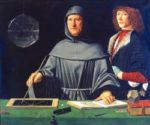This was originally published on October 27th, 2010.
Thomas F. Hale v. Commissioner, TC Memo 2010-229
Over 500 years ago Fra Luca Bartolomeo de Pacioli published a textbook Summa de arithmetica, geometria, proportioni et proportionalita. Included in the textbook was a description of the methods that Venetian merchants used to keep accounts. The method, known as double-entry became remarkably popular. During the 1980s a product known as Quicken tried to abolish double entry to the delight of many small businesses and the consternation of the world’s accountants. The makers of Quicken, thankfully, came out with Quickbooks. Now double entry is there behind the scenes. Not as many people have to learn it anymore.
Even before computers became fairly pervasive, there were people who didn’t want to learn double entry. I used to think that was odd, but then I realized that other people didn’t break license numbers down into their prime factors while driving, so maybe I was the peculiar one. If such a person needed to do record-keeping there was a solution. We used to call then “Dumb” books, but after I studied them some, I came to admire them. I only once saw somebody work the whole system thoroughly, but they did work. One-write was probably better, but Dome books worked. So I am glad to see that they still exist and can be purchased from Amazon.
Thomas Hale might have been well advised to purchase a Dome book. Thomas Hale was a professor at Idaho State University, an attorney and a landlord. God bless him, I can see why he never got to double entry. The IRS claimed that he understated his rental income and legal fees and claimed unsubstantiated deductions for 2003, 2004, and 2005 assessing tax deficiencies totaling over $60,000 and penalties over $10,000. Professor Hale petitioned the tax court. Things did not go that well.
At trial, petitioner introduced into evidence approximately 317 pages of uncategorized photocopies of receipts, canceled checks, invoices, and similar documents. He also offered copies of Federal and State tax returns that he had submitted to respondent during respondent’s examination. He made no attempt to tie that evidence to respondent’s adjustments underlying the deficiencies in question. At the conclusion of the trial, we set a schedule for briefing and provided petitioner with detailed instructions as to the form and content of briefs, directing him to Rule 151(e), which addresses that subject. In particular, we cautioned him to set forth in response to each adjustment made by respondent the facts in evidence that he believed supported his claim that respondent erred in making that adjustment. Petitioner failed to file any brief.
I must admit that I have not studied Rule 151(e). This case, however, should not have gotten beyond the agent level without categorizing the various receipts and canceled checks and tying them to the tax return. That appears to be what the Tax Court was looking for.
In support of his claim that his only income was what he reported on his return and he has adequately substantiated all of his deductions, petitioner offers us what amounts in effect to a shoebox full of papers. Petitioner has ignored our specific instructions that he link his evidence to respondent’s adjustments. We need not (and shall not) undertake the task of sorting through the voluminous evidence petitioner has provided in an attempt to see what is, and what is not, adequate substantiation of the items on petitioner’s returns
Professor Hale taught European history. Europe has had an awful lot of history so his unfamiliarity with Fra Pacioli’s contribution might be understandable. A Dome book would have done the trick for him though. Another possibility might be the deduction summary guides offered by a much more seasoned tax blogger than myself. Robert Flach still prepares tax returns by hand distrusting the “flawed software” that most of the rest of use.
What you can’t tell from reading the case is to what extent Professor Hale was denied deductions that would have been legitimate, if they had been substantiated. Assuming they were significant, he could have saved himself quite a bit by engaging a tax professional at some point in the process.































































































